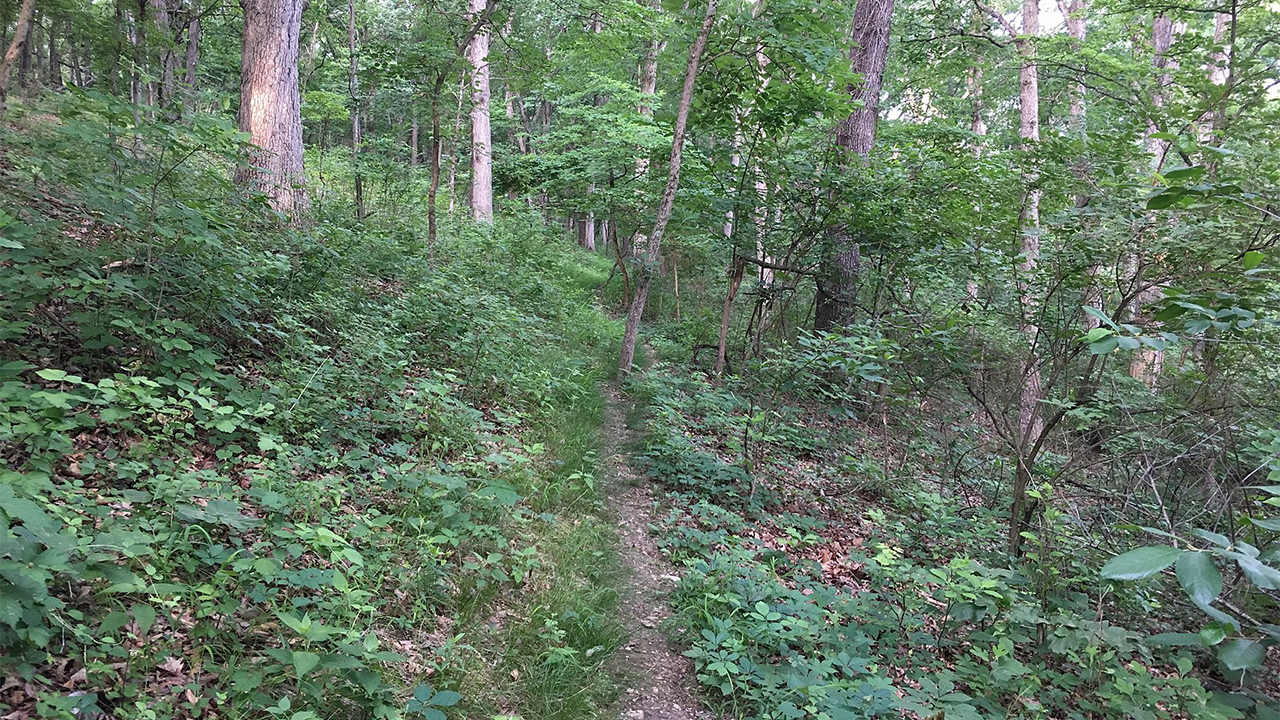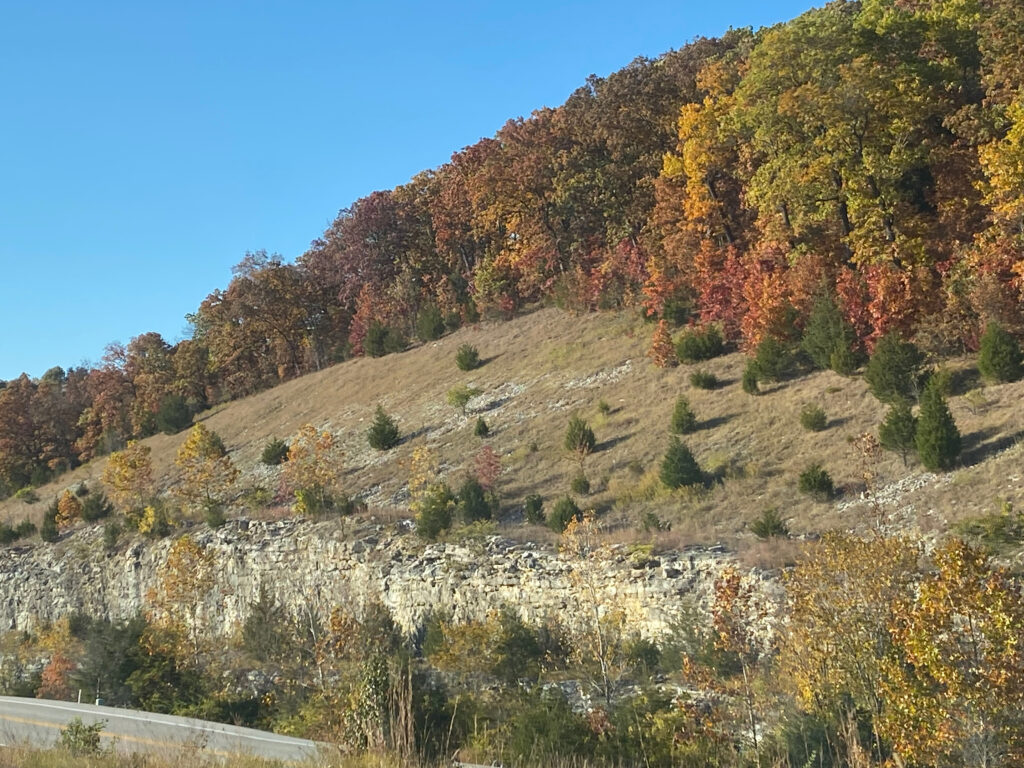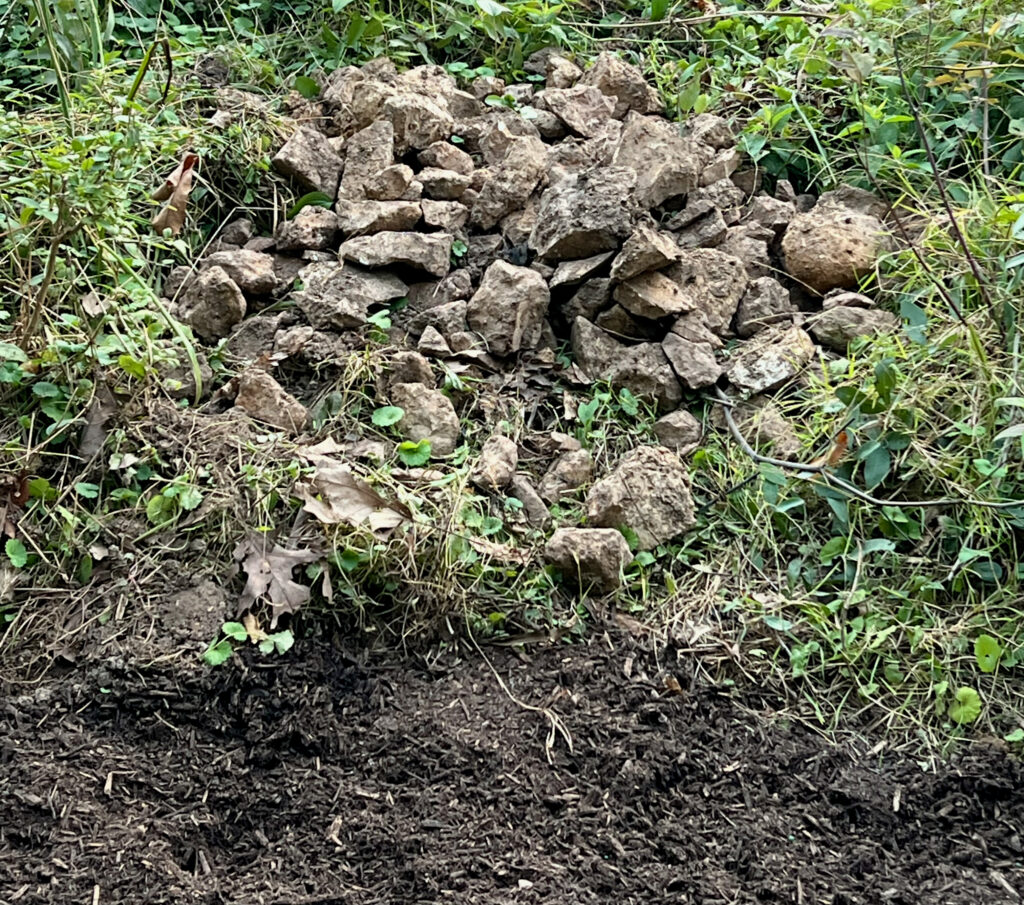
My friend was going on an international trip, and I intended to dig a late-fall garden for her while she was gone. Elle owns three acres out where the highway from the city makes a big turn and reveals forested ridges that are the start of the Ozarks. Her house is almost a thousand feet up, on property that slopes off the ridge road then falls more steeply through the trees to a creek at the bottom of the valley. Development is intense along the nearby interstate and state highways, but the terrain has slowed it here, so far.
For years Elle had large vegetable and wildflower gardens. She has the green touch but got busy with work, and they went fallow. Fencing around the vegetable plot had fallen in brittle tangles and was grown through with weeds. Long sections of U-channel posts, like the ones that hold up stop signs, leaned out at the corners or were buried under wild grasses.
She likes deep-green vegetables that are hardy and nutritious, such as kale, chard, and Chinese winter greens. Few other crops grow well on the ridges anyway, except berry brambles and some fruit trees. We stood and discussed it in her side yard, where the gardens used to be, and agreed to try to grow and harvest a few greens in the old vegetable plot before winter arrived.
Elle would have been fine pulling weeds, dropping seeds into the slope, and getting a new roll of fencing to keep the deer out. I knew that if she was safely on the other side of the world, I could do things my way and surprise her with the excellent results on her return.
The ridge is an aggregate of rocks and stones—limestone, sandstone, flint, and an unusually colorful chert—held together by dirt and clay. The first time I stuck a shovel in it I hit a rock. I moved the shovel and kicked rocks until my feet were sore. On my next visit I brought a garden fork I could at least get into the ground and pry up some oval stones, but one of its heavy tines bent within minutes from the abuse. I was a little embarrassed and told Elle I could always get a tanker bar, a six-foot steel rod that I used to use to shatter Miami limestone in the way of ornamental plantings in another friend’s yard. Before she left for her trip she bought me a pick mattock—pickaxe on one end, adze on the other—that seemed to work pretty well.
Elle would have been fine pulling weeds, dropping seeds into the slope, and getting a new roll of fencing to keep the deer out. I knew that if she was safely on the other side of the world, I could do things my way and surprise her with the excellent results on her return.
I would break the earth to remove weeds with their roots intact, so they did not grow back, and to open the soil to water. I would dig the bed level on the slope, wall the cut with stones to prevent erosion, chop the clods, and hand-turn in bags of composted dirt to lighten the clay. I would re-set four posts at the corners, everything square and true, put up new fencing, and make a little gate. I thought about a system of hoops with a removable tarp to keep the shoots safe from overnight frost for as long as possible. I dreamed of a small, framed greenhouse built on the cheap with salvaged windows.
I have dug in the earth many times, for different reasons, and not always by my own volition. I was eager to dig this little garden plot, a tenth the size of the former ones, to please my friend, of course, but also for the very fact that it would not be easy.
• • •

(Photo by John Griswold)
Elle left and would be gone two weeks. I fed her cat, fixed her chainsaw, picked up garbage thrown on her property from the road—including a tire and an entire wheel—and mowed the yard. Mowing was a hazard due to the danger of rollover, and the dust and stones that flew from under the riding mower as if it were a chopper touching down in a gravel desert. The mower bounced so badly on the uneven ground that the dead-man switch in the seat kept shutting off the engine, thinking I had fallen out of the saddle.
The slope blistered the soles of my well-calloused feet on the first day, something that had never happened to me, and my legs were sore though I ran regularly. The usable part of the yard was so steep that I had to take care just walking out to the compost pile, so I did not turn my ankles or lose balance and stagger-fall down the hill, brogans over bowler, like a silent-film actor doing physical comedy.
I have dug in the earth many times, for different reasons, and not always by my own volition. I was eager to dig this little garden plot, a tenth the size of the former ones, to please my friend, of course, but also for the very fact that it would not be easy.
My friend Larry called, and I told him the ridge felt hazardous to a flatlander. His wife is from West Virginia, and he challenged me on how hazardous Missouri could be.
I said the road up is winding, narrow, and poorly graded. A car could easily catch its tires on the edge and tumble down the grade. Elsewhere, massive trees stand inches from the road; a head-on with one would be more catastrophic than with an oncoming truck. Elle fell asleep once driving home from work and ran off the road near a hairpin turn. She counted herself lucky that a neighbor’s ATV could pull her out and that a tree broke only her windshield.
Dump trucks with beds full of gravel use the roads and have broken her windshield three other times. Signs on their tailgates say, Not responsible for broken windshields.
Trees fall in storms but hang up dangerously in other trees on the ridge. There is a downed one on her land that loggers would call a widowmaker—an old-growth oak, five feet in diameter at its base, trunk 50 feet long from where it is still attached to its high stump to its top, which rests on the slope and another tree.
I have used the chainsaw to prune standing trees on the property and to fell a couple of dead ones and cut them up. The logs and branches make good brush piles inside the tree line for small animals through the winter. I did not mess with the widowmaker, except to lop off a few non-loadbearing branches tangled in saplings and brush. It has hung there several years, and it would take an arborist with a crew and heavy equipment to get it up to the road, but the trunk looks mysteriously weightless and—oddly, in this tilted world—perfectly level.
Weird things happen up here, I told Larry. A stranger drove onto Elle’s property recently, purposely ran off the driveway, turned down the slope, and got his pickup stuck in the old vegetable plot. When she asked what in the world he thought he was doing, he said that he wanted to buy her house.
A car could easily catch its tires on the edge and tumble down the grade. Elsewhere, massive trees stand inches from the road; a head-on with one would be more catastrophic than with an oncoming truck.
I once asked Elle, as a joke about the difficulties of life on the ridge, if she had buried a problematic ex out back. She liked that one. She keeps a hatchet in her kitchen by the toaster oven, but I cannot remember why.
“Anyway, the ridge has nothing personal against me,” I told Larry, who lives in Los Angeles. “It wants to kill you too.”
I told him I think a lot about all that seasoned, centuries-old wood in the widowmaker. How a sawmill could cut fine beams from it for a house addition, with floorboards left over. You can hardly buy lumber like that now.
This may be the real hazard on a place like Hunkerdown Farm: You start thinking.
• • •

(Photo by John Griswold)
Elle’s cat is a big female tortoiseshell with a loud voice who loves to kill moles, mice, birds, and snakes. On the morning I got started on the garden she sat on a nearby stump, surrounded by garlic scapes gone to seed, enjoying the sun and staring at every rustle in the old wildflower plot.
First, I thought I would repot some mums and pansies I had bought and set them out to be enjoyed by anyone passing by. Within days the deer enjoyed my potted flowers down to the dirt.
Then I was pickaxing the earth and feeling good. The pick sunk to the hilt, every time, smashing or pushing aside stones. Despite not having used a pick in decades I could land its blows exactly where I wanted them. I raised it, swung, punched in, pried apart the dirt and clay and rocks, then found my next spot. I worked in a grid, and when I had broken a section I used the maimed garden fork or the shovel to break up the ground further. It occurred to me in the middle of this work that the little creatures I had built the brush piles for were likely to eat the future vegetables and chew into the house to boot.
I felt like a voice crying out in the wilderness. At every step there were more stones. I felt like I should read aloud from Ecclesiastes.
Many of the rocks I turned up and threw to the side were muddy limestone or sandstone with threads of iron ore, but the chert was individual stones that broke like glass under the tools. (Stones have a prideful integrity that rocks do not.) I had romantic notions about chert as a kid, because the best arrowheads, spear tips, and axes were napped from it, and I wanted to be either an Iroquois or a mountain man. But stone weapons are in less demand now, and the razor-sharp chips that flew around as I dug seemed pointlessly dangerous.
Flint, which is another kind of chert, sparked under the pick like the feet of an old devil dancing a reel. When I got tired I cussed the stones under my breath with old-timey phrases: Damn your eyes. Ods bodkins! I felt like a voice crying out in the wilderness. At every step there were more stones. I felt like I should read aloud from Ecclesiastes.
My muscles had remembered how to labor with these tools but forgot their age. Several times over the course of hours I was sure I felt a heart attack or philosophy coming on and collapsed, gasping and red, under the persimmon trees for a water break. Deer had eaten all the fallen fruit from the ground and left scat, which was easier to avoid. Mosquitoes and gnats swarmed, but I was too worn out to care. The most genuine way to give thanks for having an individual consciousness might be lying under a persimmon tree in Missouri and looking up into its branches.
I leveled the bed carefully and chopped remaining clods with the tip of the shovel; carried two-cubic feet bags of composted soil from the car and slit their bellies open with my knife; spread the rich dirt and turned it in with the fork. Funny thing was, I thought, this was not even my bit of earth, and this bit was more difficult than the ones I used to think of as mine. I started pressing stones into the small raw face of the cut I had made in the slope.
Is it neurotic to add layers of difficulty to tasks on purpose? Divers can do most of the same construction and demolition in the hostile environment of the sea that workers do topside, but they have to bring their air in lunch buckets. That is, work may need to get done anywhere, but it takes a certain kind of person to want to do it under certain circumstances.
The additional difficulties of Hunkerdown Farm reminded me pleasantly that I was out in the world, away from home, anonymous. That can be exhilarating. I felt as much myself as a stone is stony. It was not a fullness of self, like overeating, but an intensification.
The most genuine way to give thanks for having an individual consciousness might be lying under a persimmon tree in Missouri and looking up into its branches.
Besides, I like rocks and stones. I pick them up and look at them wherever I go. I bring them home as souvenirs of meaningful places, such as the Bashō trail in the mountains of Japan or a former prison for Confederate soldiers in a river town in Illinois. Sometimes I give them as gifts, if the recipients are worthy.
Rocks and stones are reality agents, signifying only their own existence. Irreality stems from perception, thought, and language. In this respect, stones are easy; people and their choices are hard.
• • •

(Photo by John Griswold)
Before I finished, I took a break and walked painfully up the hill to the road to check the mailbox. Elle’s neighbor was outside, and we talked a few minutes. I told her Elle had bought a rock farm and got every cent of her money’s worth. She liked that one and told me how she and her husband had landscaped their place across the road. They used a Bobcat, she said and smiled. I liked that one.
As I walked painfully back down the hill I noted my new plot looked exactly like a shallow grave. I tried to hammer some salvaged U-channel into the corners like bedposts, but the steel ends deformed against hidden rocks. I dug narrow holes and beat the posts in a few more inches with the back of a maul. I tamped dirt and stones around their bases, made sure they were plumb in both directions, strung a new roll of plastic fencing around them, and was done.
I drank a lot of water, ate some peanuts, showered, put on dry clothes, and looked out the window with pleasure at my handiwork. From this angle I could see that the plot and its poles were all horribly tilted and crooked—not only not level and plumb, but everything going its own chaotic way—as if a child had drawn it. What could I do but laugh? Go to hell, I thought to that thing that does not love permanence or unnatural symmetry.
Still, I had enjoyed myself in labor and looked forward to Elle’s vegetables, if they beat the frost. The leaves were turning. I was curious what I would see when they fell and revealed what was in the ravine and on the slopes across the way.
I drank a lot of water, ate some peanuts, showered, put on dry clothes, and looked out the window with pleasure at my handiwork. From this angle I could see that the plot and its poles were all horribly tilted and crooked—not only not level and plumb, but everything going its own chaotic way—as if a child had drawn it.
Elle got home and was happy with my work, though her real surprise was finding I had dug the plot somewhere she had not intended. Later we worked together expanding it, and I made my hoop system for frost protection.
One cold, dark night, Elle went out to pull the tarp over the garden and got locked out of her house, without coat, keys, or phone. She spent twenty minutes beating on the doors of the neighbor I had talked to, who was sleeping like the dead with her husband on their couch. Their dogs did not bother to bark. Despite the weirdness, everything turned out fine, as also happens on the ridge.
• • •
It has been several weeks. The greens are up but still small. We have discussed other projects. Elle wanted to use her grandmother’s charcoal-fired hotpot to make a dinner, which she brought back from her trip. I said burning charcoal indoors was a carbon-monoxide risk, and she said her people had been doing it for a thousand years. I did not know what to say to that one. We laughed and remembered the time the dessert we could not agree on had exploded in its pot and blew atomized oil all over the room and me. Miraculously, I was fine.
In the end she bought a new induction hotpot. We dropped frozen, shaved slices of lamb into boiling broth, pulled them out still slightly bloody after a couple of seconds, and dipped them in almond butter and soy. We ate all the lamb, a lot of it, by itself. Then we cooked slick shitakes, cap-headed enoki, and funky fungus in the broth and ate them. Cabbage went in as briefly as the lamb, to retain its crunch, with some parboiled rice noodles and pak choy. We ate all that.
The dipping broth became the last course, a soup, with an aggregate of coagulated blood, rendered fat, broken noodles, cabbage shred, fungus tip, and more, ladled into stoneware bowls. I had three servings, and we enjoyed the time, without much thought. It was not complicated or hard.
